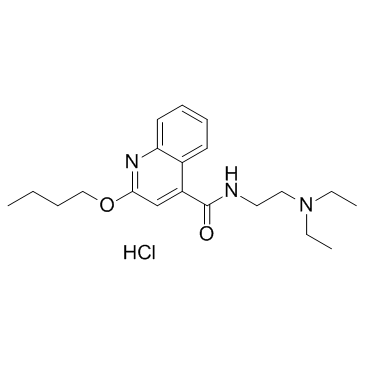Dibucaine hydrochloride
Modify Date: 2024-01-05 19:36:03

Dibucaine hydrochloride structure
|
Common Name | Dibucaine hydrochloride | ||
|---|---|---|---|---|
| CAS Number | 61-12-1 | Molecular Weight | 379.924 | |
| Density | 1.071g/cm3 | Boiling Point | 496.3ºC at 760 mmHg | |
| Molecular Formula | C20H30ClN3O2 | Melting Point | 99-101 °C(lit.) | |
| MSDS | Chinese USA | Flash Point | 254ºC | |
| Symbol |


GHS05, GHS07 |
Signal Word | Danger | |
Use of Dibucaine hydrochlorideDibucaine Hydrochloride is a local anesthetic of the amide type now generally used for surface anesthesia.Target: Sodium ChannelDibucaine is an amide local anesthetic. Dibucaine reduced the degradation of BSA-gold complex in the reservosomes, which was not caused either by an inhibition of the whole proteolytic activity of the parasite or by a reduction on the expression levels of cruzipain [1].Dibucaine, a quaternary ammonium compound, inhibited SChE to a minimum within 2 min in a reversible manner. The inhibition was very potent. It had an IC(50) of 5.3 microM with BuTch or 3.8 microM with AcTch. The inhibition was competitive with respect to BuTch with a K(i) of 1.3 microM and a linear-mixed type (competitive/noncompetitive) with respect to AcTch with inhibition constants, K(i) and K(I) of 0.66 and 2.5 microM, respectively. Dibucaine possesses a butoxy side chain that is similar to the butryl group of BuTch and longer by an ethylene group from AcTch [2]. |
| Name | cinchocaine hydrochloride |
|---|---|
| Synonym | More Synonyms |
| Description | Dibucaine Hydrochloride is a local anesthetic of the amide type now generally used for surface anesthesia.Target: Sodium ChannelDibucaine is an amide local anesthetic. Dibucaine reduced the degradation of BSA-gold complex in the reservosomes, which was not caused either by an inhibition of the whole proteolytic activity of the parasite or by a reduction on the expression levels of cruzipain [1].Dibucaine, a quaternary ammonium compound, inhibited SChE to a minimum within 2 min in a reversible manner. The inhibition was very potent. It had an IC(50) of 5.3 microM with BuTch or 3.8 microM with AcTch. The inhibition was competitive with respect to BuTch with a K(i) of 1.3 microM and a linear-mixed type (competitive/noncompetitive) with respect to AcTch with inhibition constants, K(i) and K(I) of 0.66 and 2.5 microM, respectively. Dibucaine possesses a butoxy side chain that is similar to the butryl group of BuTch and longer by an ethylene group from AcTch [2]. |
|---|---|
| Related Catalog | |
| References |
| Density | 1.071g/cm3 |
|---|---|
| Boiling Point | 496.3ºC at 760 mmHg |
| Melting Point | 99-101 °C(lit.) |
| Molecular Formula | C20H30ClN3O2 |
| Molecular Weight | 379.924 |
| Flash Point | 254ºC |
| Exact Mass | 379.202667 |
| PSA | 54.46000 |
| LogP | 4.67820 |
| Storage condition | Refrigerator |
| Stability | Stable. Incompatible with strong oxidizing agents. Protect from moisture. |
CHEMICAL IDENTIFICATION
HEALTH HAZARD DATAACUTE TOXICITY DATA
MUTATION DATA
|
| Symbol |


GHS05, GHS07 |
|---|---|
| Signal Word | Danger |
| Hazard Statements | H302-H318 |
| Precautionary Statements | P280-P305 + P351 + P338 |
| Personal Protective Equipment | dust mask type N95 (US);Eyeshields;Faceshields;Gloves |
| Hazard Codes | Xn:Harmful |
| Risk Phrases | R22;R41 |
| Safety Phrases | S26-S39 |
| RIDADR | NONH for all modes of transport |
| WGK Germany | 3 |
| RTECS | GD3325000 |
| HS Code | 2934999090 |
| HS Code | 2934999090 |
|---|---|
| Summary | 2934999090. other heterocyclic compounds. VAT:17.0%. Tax rebate rate:13.0%. . MFN tariff:6.5%. General tariff:20.0% |
| 2-Butoxy-N-[2-(diethylamino)ethyl]quinoline-4-carboxamide hydrochloride (1:1) |
| Dibucaine hydrochloride |
| MFCD00012735 |
| Benzolin (VAN) |
| Cincaine |
| benzolin |
| 2-Butoxy-N-[2-(diethylamino)ethyl]-4-quinolinecarboxamide Monohydrochloride |
| 4-Quinolinecarboxamide, 2-butoxy-N-[2-(diethylamino)ethyl]-, hydrochloride (1:1) |
| EINECS 200-498-1 |
| 2-Butoxy-N-[2-(diethylamino)ethyl]-4-quinolinecarboxamide hydrochloride (1:1) |
| 2-butoxy-N-[2-(diethylamino)ethyl]quinoline-4-carboxamide,hydrochloride |
| Dibucaine HCl |
| Dibucaine (hydrochloride) |

